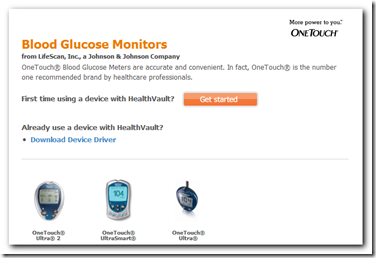Hospitals and doctors do not get paid until they provide a service, so monitoring a patient remotely has not been set up with the “codes” for payment as of yet, but who knows how this could change down the road if insurers begin to compensate physicians and hospitals to monitor patient activity electronically. There are devices on the market already that can facilitate this, and it is a mixed bag of sorts, some could be considered good technology while others may cross the line to become more intrusive. That is a decision we make ourselves today with determining what and how much electronic monitoring we can live with, but down the road some of the options may not be there when it comes to cost and compensation.
Some monitoring devices have already partnered with Personal Health Records vendors, such as Microsoft HealthVault to provide a dashboard for the consumer to connect and report activity. One advantage is that the device does the input, so no manual typing is required. This is still one more move in the direction of digital healthcare.
One example is the American Heart Association who has partnered with the HealthVault and can help and advise on blood pressure  machines that are already set up to transfer data to a computer wireless or connected, thus when reporting back to a physician for guidance on treatments, the physician gets actual numbers from the device. As a patient, you can opt to share this information with your physician under the sharing area of the HealthVault, and there are other more automated processes that are and will become available to submit to your MD on a regular basis.
machines that are already set up to transfer data to a computer wireless or connected, thus when reporting back to a physician for guidance on treatments, the physician gets actual numbers from the device. As a patient, you can opt to share this information with your physician under the sharing area of the HealthVault, and there are other more automated processes that are and will become available to submit to your MD on a regular basis.
One Touch Glucose monitors are also set up to work with the HealthVault.
The Pulse Oximeter connects via Bluetooth and provides the option for the patient to connect to their physician. You go about your daily business and activity is sent to your physician, with the HealthVault being the common area to store information.
These are just a few examples and there are more on the site, and the report is indicating by utilizing such devices and reimbursing physicians, there stands to be many millions saved. Again, this is still new and each individual and physician needs to make their own  decisions here as one device may work for one individual, the next may find it intrusive and choose another system that perhaps fits better into their lifestyle. These devices are out there and on the market and connecting to data, so it’s probably just a matter of time with the focus on saving money that we will begin seeing more innovations and progress toward this direction and hopefully devices with healthcare being the top priority and less focus on the potentially intrusive data collection side of things for profit only. BD
decisions here as one device may work for one individual, the next may find it intrusive and choose another system that perhaps fits better into their lifestyle. These devices are out there and on the market and connecting to data, so it’s probably just a matter of time with the focus on saving money that we will begin seeing more innovations and progress toward this direction and hopefully devices with healthcare being the top priority and less focus on the potentially intrusive data collection side of things for profit only. BD
The United States could cut $197 billion from its health care bill over the next 25 years by widespread use of remote monitoring to track the vital signs of patients with chronic diseases such as congestive heart failure and diabetes, according to a new study released today by economist Robert Litan. Litan said that savings would be maximized by public policy adjustments that encourage health care institutions and individual caregivers to accelerate the use of remote monitoring.
But he warned that adoption of remote monitoring and other telemedicine opportunities will be slowed and benefits reduced unless the United States does a better job of reimbursing health care organizations for remote care and encouraging continued investment in broadband infrastructure that can be tailored to meet the privacy, security, and reliability requirements for telemedicine applications.
Litan's savings estimates are tied to four specific conditions - congestive heart failure, diabetes, chronic obstruction pulmonary disease, and chronic skin ulcers and wounds.
Baseline Savings:
Heart Patients - $79.7 billion
Diabetes Patients - $42.3 billion
COPD Patients - $18.7 billion
Chronic Wound Patients - $12.5 billion
Total Baseline Savings - $153.2 billion
Policy Savings Savings:
Heart Patients - $102.5 billion
Diabetes Patients - $54.4 billion
COPD Patients - $24.1 billion
Chronic Wound Patients - $16.0 billion
Total Policy Savings - $197 billion
Gain from Policy Change:
Heart Patients - $22.8 billion
Diabetes Patients - $12.1 billion
COPD Patients - $5.4 billion
Chronic Wound Patients - $3.5 billion
Total Gain from Policy Change - $43.8 billionRelated Reading:
American Heart Association and Microsoft HealthVault Unite





0 comments :
Post a Comment